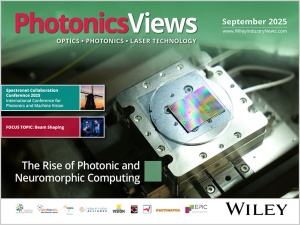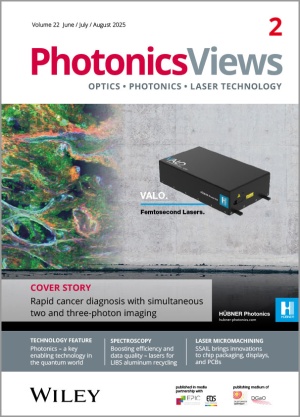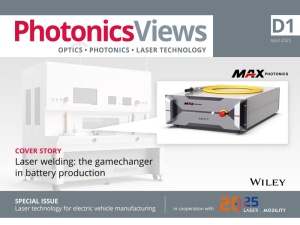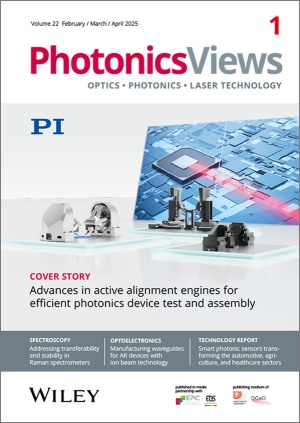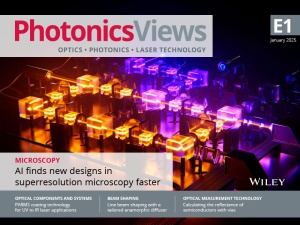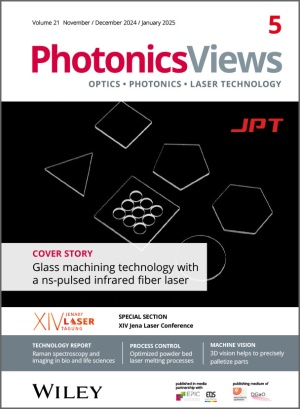Glass processing with a nano-second fiber lasers with 12 ns pulse width and 40 kW peak power from Shenzhen JPT Opto-electronics
Ausgabe lesen
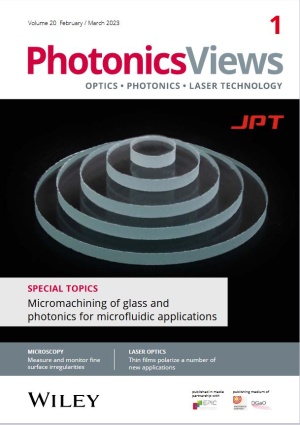
Glass processing with a nano-second fiber lasers with 12 ns pulse width and 40 kW peak power from Shenzhen JPT Opto-electronics
Samuel Bucourt (EPIC / Imagine Optic)
In early 2021, II–VI Incorporated joined the race for the acquisition of Coherent Inc. against two competitors – and succeeded. Now, about two years later and six months after completing the merger and the announcement of the rebranding as ‘Coherent Corp.’, it is time to ask chief marketing officer Sanjai Parthasarathi for a first résumé.
EPIC's photonics technologies program manager Jérémy Picot-Clémente talks to Stephan Berlitz, head of Audi lighting development.
Jérémy Picot-Clémente (EPIC)
Among the various micro and nanofabrication technologies, ultrafast laser processing is a promising tool for the fabrication of micro/nanofluidics due to its flexibility, versatility, high fabrication resolution and three-dimensional fabrication capability. In this article, we review the progress made to date by companies working with ultrafast laser processing for the fabrication of micro and nanofluidics systems.
Andreas Rudolf (nLight)
The latest application studies demonstrate how ring-shaped (‘donut’) laser beams overcome major obstacles in the laser powder bed fusion of metals. This includes key improvements in productivity and cost, a significant reduction of soot and spatter, the stable processing of difficult-to-print and crack-prone materials, and the ability to improve and spatially tailor material properties.
Gwenn Pallier (Cailabs), Jean-François Poisson (Light Conversion)
Many industrial microprocessing applications that use femtosecond lasers have been developed in a variety of sectors, including medical and semiconductors. To access new large-scale applications such as surface texturing however, robust industrial-grade beam shaping solutions need to be combined with femtosecond lasers. Cailabs and Light Conversion have developed a partnership to demonstrate the quality and robustness of their solution using a Canunda-Pulse beam shaper and a Carbide laser.
Suzue Izumi (Evident)
Surface treatment is applied to the film used in food packaging, industrial materials, and medical applications to add various surface functions, such as transparency, gloss, waterproofing, antifouling, and non-adhesiveness. This article provides examples to demonstrate how laser microscopes can be used to check the quality of various film surface properties.
Maria Loidolt-Krüger (Picoquant)
Quantitative single molecule and time-resolved fluorescence techniques offer new insights into many samples in life and materials sciences. So far, their adoption has been slow because expert knowledge was required for correct data acquisition and analysis. Now, PicoQuant have developed a new confocal microscope called Luminosa. It combines state-of-the-art hardware with cutting-edge software to deliver high-quality data while simplifying daily operation. The software includes context-based workflows for each technique. This article shows how it streamlines single-molecule Förster resonance energy transfer (smFRET) experiments.
There are many challenges in the development and production of laser systems for medical applications – and the safety requirements are significant. It is no wonder that medical technology manufacturers choose their suppliers very carefully. WaveLight, a subsidiary of Alcon and a global player in refractive surgery, successfully uses products from MKS Instruments in the development, production and maintenance of its high-quality laser systems.
Ana González (iPronics), Jim Theodoras (HGGenuine)
The implementation of coherent systems in communications involves the post-processing of the optical transmitted signal after photodetection due to the need to mitigate transmission impairments. This processing is currently performed in the electrical domain using a digital signal processing device (DSP), which increases latency, and costs in the form of power consumption and additional equipment. The use of programmable photonics in coherent systems opens the door to correcting the main transmission impairments in real-time inside the photonic chip, allowing adaptive processing through time fluctuations.
Roswitha Giedl-Wagner, Thomas Lang (both: GFH)
Ultrashort pulse lasers are the perfect tool for the micromachining of components for a wide range of applications. Even hard and brittle materials can be processed with high precision in state-of-the-art machines like the GL.smart from GFH. With pulse lengths in the pico and femtosecond range, an irradiation >1012 W/cm2 is incident on the workpiece with the potential to generate ionizing radiation. This article deals with the x-ray emissions recorded during laser turning operations and the corresponding safety measures.
Rolando Ferrini (Femtoprint)
In the last ten years, laser-based glass micromachining has become a mature technology, which is now out of the R&D labs and is finally deployed in industry as a scalable micro-manufacturing process to produce innovative optics and photonics devices. Micro-optics, integrated photonics, optical communication, innovative displays, photonic and quantum computing are among the fields that are looking at this potentially ground-breaking technology for the precision manufacturing of disruptive miniaturized devices.
René Sattler (Laser Components)
Exceptional applications require exceptional solutions. With today’s expertise and technical possibilities, complex layer designs can be built on thin-film polarizers to provide functions and applications that were previously not considered for these optics – for example as ‘luminosity boosters’ in projectors or as ‘efficiency boosters’ when generating frequency-doubled laser beams.
Benedikt Bläsi (Fraunhofer ISE), Martina Müller (3D AG), Harald Rossmeier (Toptica)
Lasers are widely used in various manufacturing processes. In order to achieve sustainable production, it is important to reduce the environmental impact caused by the laser operation. One major improvement is the step from gas lasers to diode lasers.
Oliver Fähnle, Kerstin Kern, Jan Allaart, Henrik Surberg (all: OST Ostschweizer Fachhochschule, Campus Buchs (OCB), Jens Bliedtner, Christian Schulze, Sebastian Henkel, Volker Heineck (all: Ernst-Abbe-Hochschule EAH), Jürgen Bode, Michael Wagner (both: Satisloh)
A new concept for CNC polishing pads is given by the gradient index (GRIN) pad polishing tools. Instead of gluing polishing foils as a layer onto metallic tool holders that have the spherical surface to be polished, 3D-printed GRIN pads are applied directly to the CNC tool axis.
Denny Vogel (STL Systemtechnik Leber), Tino Becker (LaCoSys)
LaCoSys Laser Control Systems specializes in manufacturing optoelectronic products. The company's electronics experts have started integrating fine-tunable Cotek power supply units into their customers' laser test systems. Featuring technology much like that found in laboratories, these power supplies have a great advantage: they not only provide voltage, they can also a deliver a precisely calibrated amount of current.


